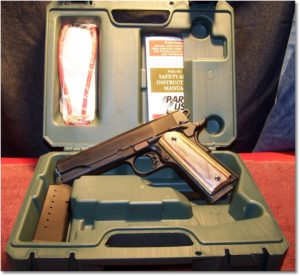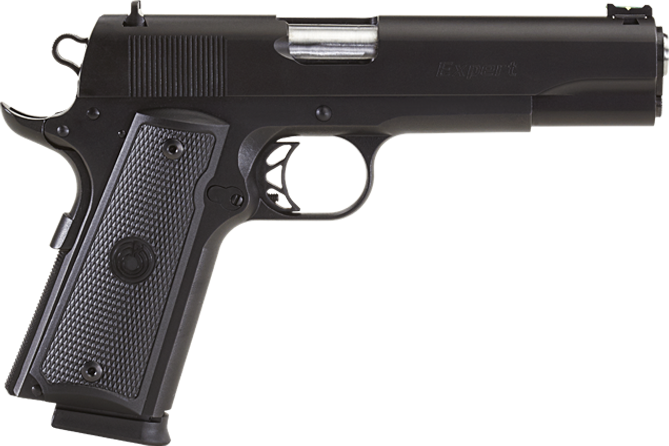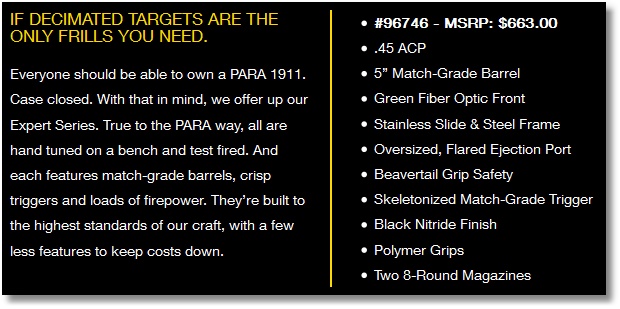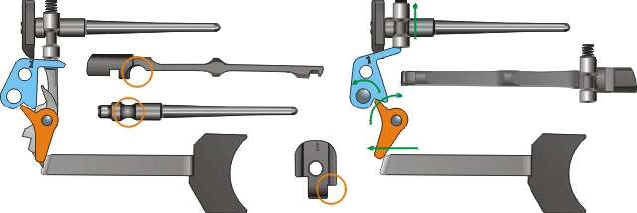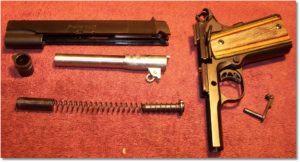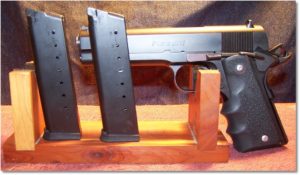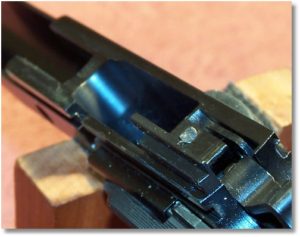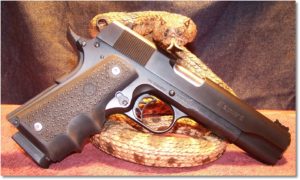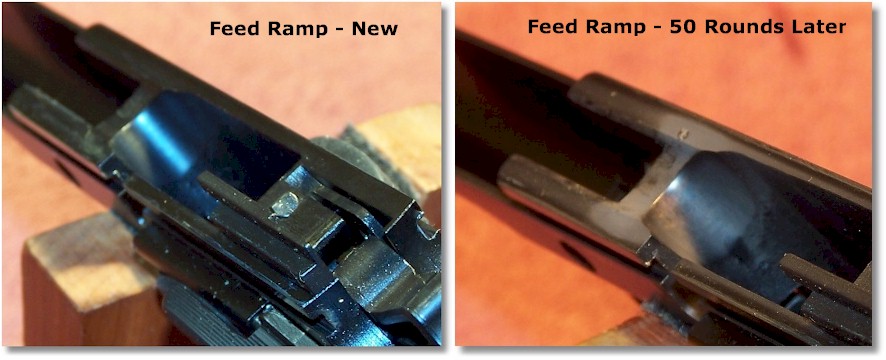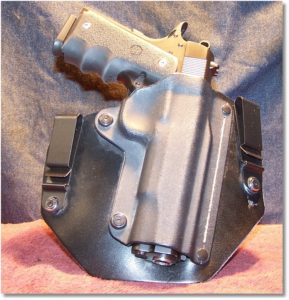Para-Ordnance, a company that specialized in the production of competition, high capacity, and double action 1911-style pistols, was founded in Canada in 1985 by two childhood friends, Ted Szabo and Thanos Polyzos. Para-ordinance; however, started out manufacturing a plastic paintball gun, the Model 85 “Dye Marking Tactical Machine Pistol”, designed for police and military training purposes. Somewhere, somehow, Para-Ordinance transitioned into manufacturing 1911-based pistols, was the first to produce a double-stack 1911, and was also the first to produce a “Double-Action-Only” 1911.
In January 2009, it was announced that the U.S. headquarters for Para-Ordnance’s U.S. subsidiary (Para USA) would be set up in Pineville, North Carolina. Eventually, Para Ordnance moved to North Carolina and became a totally U.S. company, Para USA.
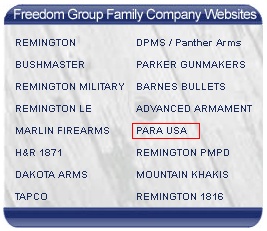 In 2012, with a goal of expanding its handgun line, ROC (Remington Outdoor Company, a subsidiary of Freedom Group) acquired Para USA (“Para”) and Para-USA became a Freedom Group member.
In 2012, with a goal of expanding its handgun line, ROC (Remington Outdoor Company, a subsidiary of Freedom Group) acquired Para USA (“Para”) and Para-USA became a Freedom Group member.
In 2014, ROC announced its new, world-class firearms center of excellence in Huntsville, Alabama. Here, Remington is integrating product development, engineering, production, and quality control – a first in Remington’s 200-year history. The integration of modern sporting rifles, suppressors, and Remington pistols commenced immediately, and Para moved to Huntsville, Alabama in March of 2015.
I purchased my Para – USA Expert in September of 2013 at a time when Para-USA pistols were still manufactured in North Carolina. With the exception of factory testing, and until this review, the Para – USA Expert has not been fired. Now, you may ask who in their right mind would purchase a firearm and not shoot it until threes years after its purchase. It is definitely not a 1911-based that has any investment value. Well, I never claimed to be in a right mind and I was simply in a 1911-buying frame of mind that, according to some plastic pistol lovers, would be proof that I am outside to the human race. Nonetheless, the Para – USA Expert was purchased (along with a Para-USA model 14-45) and my current collection of 1911-based pistols began with these purchases. You just have to start somewhere, I guess.
So without further bantering about my sanity, let’s take a look at the Para – USA Expert 1911 in somewhat detail – at least the version that I have.
THE SPECS:
The specifications today are pretty much the specifications of three years ago, the features are pretty much the same, and life has pretty much moved on as usual for Para-USA. The basics for the Para-USA Expert (formerly known as the GI Expert) are shown below:
The Para-USA Expert is an “entry-level” 1911-based pistol that shares many of the upgrades included by other companies who make “entry-level” 1911-based pistols that, according to many, are all of them unless their name is Nighthawk Custom, Les Baer, Ed Brown, Wilson Combat, or Bob’s Bargain Basement and Bead Blasting Services, LLC who specializes in fitting slide to frames with a 10-ton hydraulic press.
Since the Para-USA Expert is priced comparably with other “entry-level” 1911-based pistols, like those from Rock Island Armory, one might question the quality of such pistols. To put it simply, don’t expect Nighthawk Custom, Les Baer, Ed Brown, Wilson Combat, or Bob’s Bargain Basement and Bead Blasting Services, LLC who specializes in fitting slide to frames with a 10-ton hydraulic press quality. Well, expect better than the quality of Bob’s Bargain Basement and Bead Blasting Services, LLC who specializes in fitting slide to frames with a 10-ton hydraulic press.
SLIDE AND BARREL
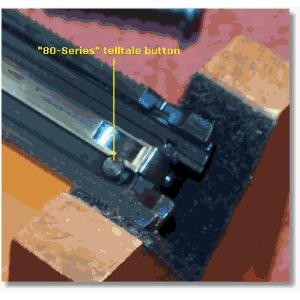 The slide material is of forged stainless steel that has been Nitride treated. PARA 1911 is roll marked on the left side of the slide and Expert is roll marked on the right side of the slide. I can’t say that roll marking is of high quality but all letters and numbers are visible. The slide consist of two dovetail slots for sights and rear serrations of 15:1 for easy grasping of the slide. No front serrations appeals to most 1911 purists. The ejection port has been lowered and flared to assist in expelling fired cases.
The slide material is of forged stainless steel that has been Nitride treated. PARA 1911 is roll marked on the left side of the slide and Expert is roll marked on the right side of the slide. I can’t say that roll marking is of high quality but all letters and numbers are visible. The slide consist of two dovetail slots for sights and rear serrations of 15:1 for easy grasping of the slide. No front serrations appeals to most 1911 purists. The ejection port has been lowered and flared to assist in expelling fired cases.
In keeping with 1911-based design, an internal extractor provides the case grab while a standard ejector provides the push out of the chamber for the .45 ACP case.
The slide, unfortunately to some, including myself, caters to the “80-Series” of 1911 (https://www.youtube.com/watch?v=chEOAb0C2Is). Now, I owned an “80-Series” Colt MKIV “Government” model 1911 and experienced no problems with it. I have yet to pass judgment on the Para “Expert” and I do talk about the trigger later.
The 5” barrel is a “Match-Grade” unit that utilizes the conventional JMB “Swinging Link” design. A 1:16 LH twist provides bullet stability and the barrel locks up tighter than a drum when in battery. Full support to the cartridge case is provided.
The Para Expert has a standard guide rod instead of the full-length guide rod that is popular these days. Nested around the guide rod is a strong recoil spring that is held into place by the Recoil Spring Plug at the front of the slide.
A standard barrel bushing keeps the barrel in line and barrel lock-up is provide by the usual barrel lugs and corresponding locking slots in the slide. The barrel is well finished and is actually better finished than I have seen on higher priced 1911s.
A “Peek-See” slot is milled into the rear of the barrel that allows you to “Peek ‘n See” if a cartridge is chambered. It seems that this method of verifying that a pistol is loaded is becoming popular. Of course, the use of a standard guide rod system allows the proverbial “press check” and we 1911 veterans usually prefer it.
The black Nitride treatment is nicely applied and provides a “satin” look to the slide.
FRAMING IT IN
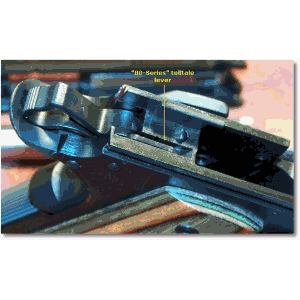 The frame of the Para-USA Expert appears to be cast steel rather than forged; separation lines pretty much indicate a cast frame that, like the slide, has been black Nitride treated. Now, before you get all in a huff about cast frames, consider that Ruger has been using investment casting for many, if not all, of its firearms. In fact, Ruger and Para-USA are leaders in investment casting for the firearms industry. Consider also that STI uses investment casting, and STI is no slouch when it comes to making high-quality 1911 pistols.
The frame of the Para-USA Expert appears to be cast steel rather than forged; separation lines pretty much indicate a cast frame that, like the slide, has been black Nitride treated. Now, before you get all in a huff about cast frames, consider that Ruger has been using investment casting for many, if not all, of its firearms. In fact, Ruger and Para-USA are leaders in investment casting for the firearms industry. Consider also that STI uses investment casting, and STI is no slouch when it comes to making high-quality 1911 pistols.
What I find interesting is that the frame actually has two textures. The side of the frame is smooth as if it were bead blasted. The bottom side of the frame, to include the trigger guard and the front strap actually has a little more texture to it than does the side of the frame. The difference in texture is actually quite nice and is visually appealing to me.
Although there is no checking or serrations on the front strap, the hammer spring housing is of nicely-checkered polymer, which is common on all but select 1911s these days, with the exception of Ruger, which has a checkered aluminum hammer spring housing as standard fare for a production-pistol.
Just above the Mainspring Housing sits a now-standard beaver-tail grip safety with memory bump that almost guarantees the hand will press the grip safety when gripping the pistol. The beaver-tail safety is well-fitted to the frame of the pistol.
A skeletonized “combat” hammer resides nicely in the cup of the beaver-tail grip safety when the pistol is fully cocked. The Main Spring is substantial.
The left side thumb safety is just that – left side only. No ambidextrous safety used in this pistol. The thumb safety operates in the usual fashion of thumb safeties where down is fire and up is safe. The thumb safety moves to these two positions in a positive manner, although the thumb safety feels gritty when new. Some use should remove the gritty feeling.
As with most 1911-based pistols, the plunger tube is a staked unit. The Slide Stop Plunger, Safety Catch Plunger, and Plunger Spring maintain an adequate amount of tension on the Safety Catch (thumb safety lever) and Slide Stop assemblies.
The Slide Stop, on my particular pistol, was not treated adequately for it to match the slide and frame. While I do find this disconcerting, it is not uncommon to find and is attributed to the different treatment process to different parts at different times during a pistols creation.
Slight cut-outs are provided in the rear of the trigger guard to better facilitate the trigger finger for short-fingered folks. The trigger guard itself is nicely rounded and large enough to accommodate the trigger finger of a shooting glove – with a finger inserted – in the glove – and then inserted into the trigger guard. Oh, you know what I mean!
LET’S GET A GRIP ON IT, SHALL WE?
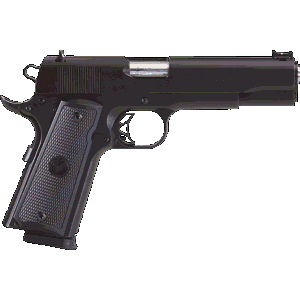 The Para Expert comes with (shudder) plastic grip panels and these are, usually, the first things to be replaced, which I did, like immediately upon getting the pistol home. A set of Hogue laminated grip panels was installed and life was better. However, if this pistol was to be shot in all seriousness, a Hogue Rubber Wraparound grip would be installed. But, that’s a personal thing with me and serious-carry 1911 pistols. I talk about that installation a tad later in the article.
The Para Expert comes with (shudder) plastic grip panels and these are, usually, the first things to be replaced, which I did, like immediately upon getting the pistol home. A set of Hogue laminated grip panels was installed and life was better. However, if this pistol was to be shot in all seriousness, a Hogue Rubber Wraparound grip would be installed. But, that’s a personal thing with me and serious-carry 1911 pistols. I talk about that installation a tad later in the article.
Just below the grip panels is something that has become known as the magazine insertion point, or otherwise referred to technically as – the “mag well.” The beveled mag-well assists the operator in inserting a magazine until it is locked into place with the Magazine Catch, which is slightly extended and allows the operator to expel the magazine from the well after use. And no, the Magazine Catch is not ambidextrous like on some of those “other” pistols.
Speaking of magazines, the Para Expert came with two 8-rounds units that are excellent. Polymer, anti-tilt followers and a metal-reinforced slide lock point makes a good system. In addition, the magazines incorporate a removable polymer base plate, which means that you can spend quality time in front of the television while disassembling, cleaning, lubricating, and assembling magazines to your hearts content, or at least, until your wife catches you.
The last thing that I need to mention is that the Para-USA Expert is lacking a polished feed ramp. In fact, the feed ramp is treated in the same manner as the rest of the pistol – a black Nitride finish. Am I bothered about this? Should I be bothered by this? While I am used to seeing a somewhat finished feed ramp on most 1911-based pistol, was this unfinished feed ramp worthy of concern? Read more about it in RANGE DAY – POST OP.
FIT ‘N FINISH
Overall, the fit and finish of the Para Expert is very nice with a minute amount of acceptable slide-to-frame play with the hammer cocked. When in battery, the slide-to-frame fit exhibits no play.
The over-all look and feel of the Para Expert is all 1911 with modern upgrades to the original design.
As far as looks and appeal, I have found that one can over-do things and it is sometimes best just to keep things simple, and the Para-USA Expert is just simple, although the “”80-Series” safety mechanism does complicate matters a bit.
SIGHTS
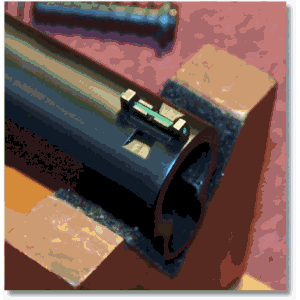 My particular Para Expert came equipped with a plain-Jane, square notch, drift-adjustable for windage rear sight and a green, light-pipe fiber optic front sight that is also drift-adjustable for windage. Nothing like trying to fit a round peg in a square hole, but the sight setup seems to work well in daylight and nicely lit rooms.
My particular Para Expert came equipped with a plain-Jane, square notch, drift-adjustable for windage rear sight and a green, light-pipe fiber optic front sight that is also drift-adjustable for windage. Nothing like trying to fit a round peg in a square hole, but the sight setup seems to work well in daylight and nicely lit rooms.
Personally, I am finding that a plain-Jane rear sight with a simple dot or painted front sight is more than adequate for most applications.
Additional light pipes are not provided.
SAFETIES
The Para Expert has the usual 1911 safeties; grip safety, thumb safety, and disconnect safety. Plus, you get the “80 Series” 1911 safety and, of course, the keep the trigger finger off the trigger until you are ready to fire safety that should be embedded in every operator’s psyche.
TRIGGER
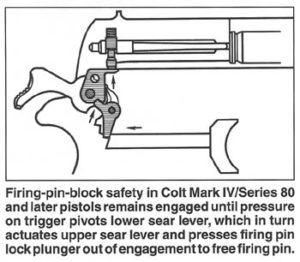 The Para Expert is equipped with a Skeletonized “long” trigger with an over-travel adjustment screw. There is no over-travel to speak of. Unfortunately, and when new, the trigger is quite gritty when pressing it to the rear to release the hammer.
The Para Expert is equipped with a Skeletonized “long” trigger with an over-travel adjustment screw. There is no over-travel to speak of. Unfortunately, and when new, the trigger is quite gritty when pressing it to the rear to release the hammer.
As was mentioned previously, the Para Expert incorporates the “80-Series” 1911 lock works, which means that there is a whole lot going on, that should not have to go on, in order to drop the hammer. In short, it makes a good trigger into a bad trigger and a bad trigger into a worse than bad trigger. With that said, I purchased the pistol knowing it was an “80-Series” and now I have to deal with it.
There is very little take-up (trigger slack) until resistance is felt. The let-off (release) is crisp. However, the journey getting to the point of release is a rough one. For want of a better description, I’m just going to call it a “sex at the beach” trigger, where pain and pleasure is experienced at the same time.
Using a digital trigger pull gauge, the final average was a gritty 5.4 pounds! It was not the weight that bothered me, because I consider a 5-pound trigger a good trigger for defensive use. The grittiness grated on my nerves. It was time to go to work with the simplest means available to me – dry firing.
A Snap-Cap was loaded up and most of the grittiness disappeared after about thirty dry fires. Perhaps, things were not so bad after all. However, there remained just the slightest hint of grit just before the trip point was reached. Only some range duty, and more trigger work, would tell the true story. However, before going to the range, there was still one thing to do – and it proved to be a challenge.
THE EVER-TIGHTENING GRIP OF FATE!
My favorite and highly qualified gunsmith has always told me that the less I have to do to the grip panels on a 1911, the better off I would be. In this case, I had to agree with him.
While the Hogue Exotic Laminated grip panels looked great on the pistol, and I experienced no issues when installing them, I still desired my favorite grip for a concealed carry 1911 and just general all-around shooting; the Hogue Rubber Wraparound Grip with Finger Grooves. No, they are not pretty, but they are highly functional in my hand and the grip just works for me. And, that’s when the fight began.
I already had the grip, the desired stainless steel grip screws (for some contrast on the pistol), and began removing the grip screws that secured the nice Hogue laminated grip panels. The Hogue laminated grip panels came with small o-rings that prevent the grip screws from backing out while shooting the pistol and that became an issue. The bottom left Stock Screw Bushing decided to come out with the grip screw. That meant replacing one Stock Screw Bushing that, luckily, I had on hand. Once the grip panel was removed, the Stock Screw Bushing was replaced. Onward!
When installing the new grip screws, the upper-right Stock Screw Bushing just did not feel right; the screw was just too tight a fit. So, the upper-right Stock Screw Bushing was also replaced (this is why it is good to keep some spare parts for the 1911 in stock).
Finally, the Hogue Rubber Wraparound Grip with Finger Grooves was installed and I considered the Para-USA Expert range-ready. The pistol felt good in the hand due to my familiarity of the grip. In fact, the pistol feels like every other 1911 pistol that has this grip installed; familiarity breed confidence.
RANGE DAY
Fifty rounds of Aguilla 230-grain FMJ (830 fps) and a magazine full of Gold Dot 230-grain JHP (890 fps) accompanied me to the range. I already knew what to expect out of the Aguilla 230-grain FMJ, as I used it to zero my Rock Island Armory 1911 FS Standard, which would serve as a baseline for evaluating the Para-USA Expert. I also knew what to expect from the GSHP as some also had been shot from the RIA. Both pistols, the RIA and the Para-USA are a close match; I figured the range results would be close, but not identical. The front sight height on both pistol is nearly identical (as close to 0.615” as I could measure) and it was to be an interesting range day.
The game plan was to shoot five rounds for function testing and then bench-rest a full magazine of 8-rounds at 7 yards, 15 yards, and again at 25 yards to get an idea of accuracy, grouping, and a relative “natural” zero for the pistol. Point of aim was to the center of the bulls-eye as I could manage. I hoped that with initial testing out of the way, I could follow-up with a magazine of GDHP at 7 yards and put the “Mozambique Drill” to the test. While not a torture test by any means, I would get an indication of the pistol’s worthiness and potential as a pistol to be used for personal defense purposes. Let the games begin!
Impact on the target at seven yards was slightly low. Impacts at fifteen yards were almost point of aim. Impacts on the target at twenty-five yards were slightly high from POA. Considering the rough trigger on the pistol, I was highly satisfied with the results and commenced firing some free-handed “Mozambique” drills at ten yards. To put it simply, if you do your part bullet impacts will be highly effective.
While the trigger was a little contrary for bench work, it proved itself worthy of free-hand work, and as long as I followed through with my shots, the round impacted the target with no surprise strays.
RANGE DAY – POST OP
One of my previous mentions was the lack of a polished feed ramp and if I should be concerned about this. Also, and after disassembling the pistol, to see if there were any others things that should concern me. It seems that not having a polished feed ramp was not worthy of concern. All ammunition, including Speer Gold Dot Hollow Point (my carry ammunition) fed with no complaint or issue. The Para-USA, like many 1911-based pistols being manufactured these days, is one of those pistols that is ready for work out of the box.
SLIDING IT HOME!
The Para Expert is only one of a long list of 1911-based pistols manufactured by Para-USA. Para-USA is especially known for the Warthog and the high-capacity 14-45.
Para-USA 1911-based pistols are made in the U.S of America and are a good value for the money paid. The Para-USA 1911-based pistols are primarily chambered for the .45 ACP cartridge; however, a 9mm version is now available with a 8+1 capacity.
The Para-USA Expert is in heavy competition with the likes of Rock Island Armory, Citadel, and Sturm Ruger and their line of SR1911 pistols. However, the closest contender (pricewise) to the Para-USA Expert is the Rock Island Armory “Rock” Standard FS. Unlike the Para-USA Expert; however, the RIA is a “70-Series” variant with a Parkerized finish, plain-Jane sights all around, and an ambidextrous thumb safety.
For an inexpensive “utility” pistol, the Para-USA Expert would fit the bill nicely. In the end, the bad guy doesn’t care what firearm that you are carrying, he is just concerned that you are carrying a firearm in the first place.
I did try to contact Bob’s Bargain Basement and Bead Blasting Services, LLC who specializes in fitting slide to frames with a 10-ton hydraulic press, to get an idea how he did a slide to frame fit using cylinder honing compound and his Hyundai-powered reciprocating sanding system. My phone calls; however, went unanswered.
THE LAST WORDS – NO REALLY!
I consider the Para-USA Expert 1911 a pistol for the experienced 1911 operator, although the pistol is an “entry” level model. The experienced 1911 operator knows what to expect from a 1911-based pistol and can determine if features, or lack of, is worth the purchase of any given 1911. Someone who is not educated in 1911-based pistol operation may not be able to detect a bad pistol from a good pistol – especially with inexpensive pistols, and there are many on the market.
For the first time 1911 buyer, I propose that you consider a 1911 of the highest quality that you can afford, be it a Ruger SR1911, a Springfield, or perhaps even a Colt or Kimber if that’s what your heart desires. One thing that you don’t need is a 1911-based pistol that will disappoint you the first time with it and sour your opinion about the 1911 platform. If you have access to 1911-based pistols at your local range, rent them and shoot them to receive an education in what the 1911 platform is all about. If you know someone who already owns a 1911, perhaps they will let you shoot theirs. As with anything, the more background you have on it, the more intelligent you become about it.
I have owned and shot various 1911-based pistols that incorporate the “70-Series” and “80-Series” trigger mechanism and have found good and bad with both of them. In general, the “70-Series” pistols have better triggers than the “80-Series” pistols and can be tuned for a modest price. The “80-Series” pistols, while more complicated in nature, can be found with excellent triggers from the factory. Tuning an “80-Series” trigger; however, takes more work by a competent and certified gunsmith, and normally at a greater expense over “70-Series” pistols. With that said, and to me, it is better to accept the “factory” trigger in a pistol meant for personal protection than to alter it and possibly open myself to unwanted litigation. For range use only, for competition, and for plinking, I have no problem with enhancing a trigger.
Next up for review in the near future – The Para-USA 1911 14-45
DON’ TAKE MY WORD FOR IT:
Here is where I include links to other reviews, primarily videos, which you might be interested in viewing with regard to the Para-USA Expert pistol.
- Para GI expert 45acp review: https://www.youtube.com/watch?v=uxRxP4zF36U
Para 1911 Expert Review: https://www.youtube.com/watch?v=Sh-7KsWWaWo - Para Expert 1911 – First Impressions: https://www.youtube.com/watch?v=sAWanopEI2k
Para GI Expert 1911 .45ACP Pistol Review: https://www.youtube.com/watch?v=dQ6GqBp-VHc - Para GI Expert 1911 Video Review: https://www.youtube.com/watch?v=GzCRo_yTejc
RESOURCES:
- Para-USA Expert: http://para-usa.com/2013/firearms/expert/expert.php
- Access to all Para-USA Products: http://para-usa.com/2013/index.php
- Forged vs. Cast: http://www.gunnuts.net/2008/11/10/forged-vs-cast/
- Investment casting: https://en.wikipedia.org/wiki/Investment_casting
![]()


